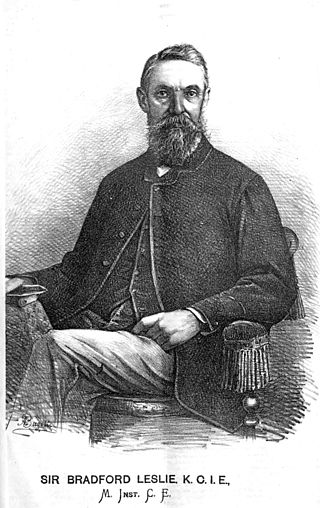
Sir Charles BarryFRS RA was a British architect, best known for his role in the rebuilding of the Palace of Westminster in London during the mid-19th century, but also responsible for numerous other buildings and gardens. He is known for his major contribution to the use of Italianate architecture in Britain, especially the use of the Palazzo as basis for the design of country houses, city mansions and public buildings. He also developed the Italian Renaissance garden style for the many gardens he designed around country houses.

Sir John Wolfe Barry, the youngest son of famous architect Sir Charles Barry, was an English civil engineer of the late 19th and early 20th century. His most famous project is Tower Bridge over the River Thames in London which was constructed between 1886 and 1894. After receiving a knighthood in 1897, he added "Wolfe" to his inherited name in 1898 to become Sir John Wolfe Barry.

Charles Barry Jr. (1823–1900) was an English architect of the mid-late 19th century, and eldest son of Sir Charles Barry. Like his younger brother and fellow architect Edward Middleton Barry, Charles Jr. designed numerous buildings in London. He is particularly associated with works in the south London suburb of Dulwich.

Henry Marc Brunel was an English civil engineer and the son of engineer Isambard Kingdom Brunel and grandson of civil engineer Marc Isambard Brunel.

Sir John Hawkshaw FRS FRSE FRSA MICE, was an English civil engineer. He served as President of the Institution of Civil Engineers 1862-63. His most noteworthy work is the Severn Tunnel.

Sir John Fowler, 1st Baronet, KCMG, LLD, FRSE was an English civil engineer specialising in the construction of railways and railway infrastructure. In the 1850s and 1860s, he was engineer for the world's first underground railway, London's Metropolitan Railway, built by the "cut-and-cover" method under city streets. In the 1880s, he was chief engineer for the Forth Bridge, which opened in 1890. Fowler's was a long and eminent career, spanning most of the 19th century's railway expansion, and he was engineer, adviser or consultant to many British and foreign railway companies and governments. He was the youngest president of the Institution of Civil Engineers, between 1865 and 1867, and his major works represent a lasting legacy of Victorian engineering.

The Tattenham Corner line is a branch line in Southern England that runs between Purley in South London and Tattenham Corner in Surrey.
Cuthbert Arthur Brereton was a civil engineer and a partner of Sir John Wolfe Barry. Together they completed numerous projects in England and Wales, the most prominent being the King Edward VII Bridge over the Thames at Kew, London.

Robert Maitland Brereton was an English railway engineer in India. In the United States he helped secure the first Act of Congress for the irrigation of California.

James Meadows Rendel FRS was a British civil engineer.

The Bengal Nagpur Railway was one of the companies which pioneered development of the railways in eastern and central India. It was succeeded first by Eastern Railway and subsequently by South Eastern Railway.

Mumbai Port Trust is a port which lies midway on the West coast of India, on the natural deep-water harbour of Mumbai (Bombay) in Maharashtra.The harbour spread over 400 square kilometres (150 sq mi) is protected by the mainland of Konkan to its east and north and by the island city of Mumbai to its west. The harbour opens to the south to the Arabian Sea.

Sir Charles Fox was an English civil engineer and contractor. His work focused on railways, railway stations and bridges.

The Jubilee Bridge is a former rail bridge over the Hooghly River between Naihati and Bandel in West Bengal, India. It provided an important connection between Garifa railway station and Hooghly Ghat railway station.

Sir Bradford Leslie KCIE (1831-1926) was an English civil engineer who specialised in bridges and was a pupil of Isambard Kingdom Brunel. His most notable achievement was the 1887 Jubilee Bridge.

John Harry Grainger was an Australian architect and civil engineer, who was also the father of musician Percy Grainger. He designed 14 bridges, notably Princes Bridge in Melbourne. As an architect, he designed half a dozen major public buildings, mainly in New Zealand, Perth, and Melbourne, notably the WA Supreme Court, while he was Principal Architect in the Architectural Division of the Public Works Department of Western Australia. He also designed some major commercial buildings in Melbourne such as George’s Store over his long career, between 1878 and 1915.
The Chinese Engineering and Mining Company, Limited, was established with foreign capital around 1879 to mine coal for the steamships of the Chinese Merchants' Steam Navigation Company and the Imperial Chinese Navy. English mining engineer Robert Reginald Burnett, MICE, directed the first shaft at Kaiping near Tangshan, Hebei Province, in 1879. The tram line between the mine and its canal to the Hai He eventually developed into the Imperial Railway of North China and the modern Jingha Railway, the civil engineering partnership Sir John Wolfe-Barry and Lt Col Arthur John Barry being appointed Joint Consulting Engineers to the Company at the end of the nineteenth century.

The Shanghai–Nanjing or Huning Railway is a 1,435 mmstandard gauge railway in China running from Shanghai to Nanjing. The railway is about 307 kilometers (191 mi) long. The Huning line is one of the busiest in China.

Frederic Charles Danvers (1833–1906), often Frederick, was a British civil servant and writer on engineering. The Superintendent of the India Office Records between 1884 and 1898, he was also a historian and wrote works on India.

William Archer Porter Tait FRSE FRMS MICE (1866–1929) was a 19th/20th century Scottish civil engineer and part of the Guthrie Tait dynasty. He was Vice President of the Institute of Civil Engineers in 1929.
















